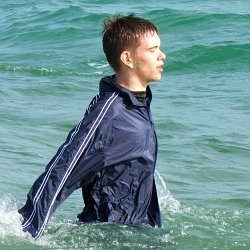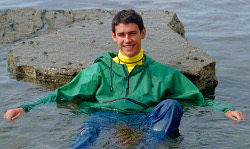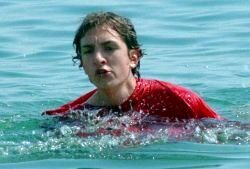Hike with the Tide!
Hiking with the tides is a very interesting component of a coastal hike. Depending on how much time you have, it can allow for a leisurely hike compared to others, since you are at the mercy of the tide charts so you can’t always go as far as you’d like in a day.
The tide can trap you! Do not attempt to round headlands without knowledge of the tide heights and times. Along the ocean, rising water can corner you below cliffs.
The first thing to consider when planning your hike on a coastal trail are the intertidal zones. Parts of the trail may be impassable during high tide. This speaks to the unique experience the coast trail gives the hiker, but it is also a dangerous aspect.
Do not attempt to hike when the trail is washed in water. People have died along the coast trying to beat the tide. Some headlands require low tides for passage. Some can NEVER be rounded safely even at the lowest tides, so overland routes must be taken.
Swim while you wait for the Tide
There is plenty of time to swim and rest while waiting for the tide to change. Along the shore maybe many spots to wade into the shallow water and explore. You'll probably get very wet, so dress accordingly. On most beaches just after high tide can be the best time to go into the water. The currents will slow down for a while.
Always keep in mind that waves can move beach logs, which can crush and kill. Strong currents, cold water, and hidden rocks make swimming hazardous. Be vigilant for large swells. Never underestimate the ocean.


Tidal Map
Before traveling along the coast, obtain a detailed topographic map. Your map should indicate areas where tides may be a problem, and the tidal height at which headlands become hazardous or impossible to round.
Tide Chart
Tide charts are available at some ranger stations. It is imperative to use the tide chart and time your hike accordingly. Head for the impassable zones when the tide is going out. Because of this, you may have to hike the coast trail at odd hours.
DON'T GUESS! Know when tides occur and carry a watch. Refer to tide charts before setting out on longer coastal hikes. On the same low tide, it may be possible to get around one headland but not the next.
Strong winds can make tides higher than tide charts indicate, sometimes flooding normally passable routes. Winter storms can significantly elevate tides and create seriously hazardous conditions.
How to Use a Tide Chart
Tide charts give the time and height of morning and evening high and low tides in good weather. Look over your map for the route you will follow. Note any locations where you see the words "Danger," "Caution," or "Go round at low tide." If your map does not include this type of information, obtain a map with those references.
See the map key for definitions of hazards. They will vary between maps.
"Danger" usually means that a headland cannot be rounded at any time by walking on the beach.
"Caution" usually suggests a low tide height below which it may be safe to round headlands.
Check the time and height of the two low tides for the day you will be hiking. Note that occasionally there may be only one low tide per day. The safest time to round headlands is within one to two hours before low tide. Rounding a headland on an incoming tide can be dangerous.
Transit
Transportation is another consideration when planning your hike. Smart people choose to team up and leave one vehicle at the trailhead and another at the other end.
Some coastal hotels or hostels have shuttles available
which drop you off at the trailhead from where you head back to your accommodation
and finish your hike with a resfreshing swim in the sea.
A warm shower awaits you to rinse your wet clothes from salt and sand.
Reader Story: Rainy West Coast
by Rhys and Tom from WalesIn the summer it rains a lot on the west coast where we live. We hike through the woods, lakes and streams, and along the tidal zones of the coast. Open water swimming can be exciting, exhilarating and it gives us a huge sense of achievement. Getting wet is just part of the trek.
The main points for us are that nothing is perfect, and staying 100% dry isn’t feasible in most rainy weather. From experience we know that we'll get very wet during our adventures, so we prepare for it and have a great time in the rain.
For most outdoor activities, like hiking, running, canoeing or swimming, we wear some kind of rain clothes, usually long cagoules, anoraks, hiking capes or ponchos. When it's warm we get soaking wet in cargo pants and hoodies.


Some say that it is best to train in a pool for outdoor sports like coastal hikes and such. We always swim in our hiking clothes to get fit. That way we're better prepared for the frequent swims through lakes and rivers.
We found a pool that lets us swim in clothes as long as they are only used for swim training. No problem. We bought rain pants, fleece tops, sports shirts, and a variety of cagoules and hiking capes with sleeves just for the pool training.
Twice a week we go to the pool. Before we jump in, we shower in our sports clothes, then put the rain clothes on. Our sessions include a lot of jumping in and climbing out to get fit. Not easy in all the wet clothes, but huge fun and very healthy.


We enjoy our training a lot.